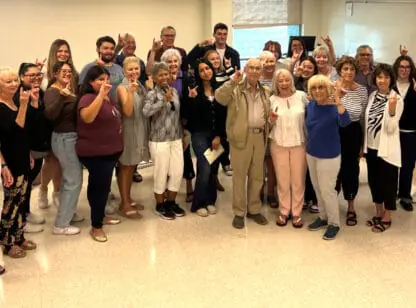One thing experts do agree on is that technology is changing the way we’re interacting socially.
Technology can be a very effective tool in reducing social isolation, especially among senior citizens, by enhancing communication and connectivity between friends, family and caregivers. Research shows belonging to social groups and networks is just as important a predictor of health as are diet and exercise.
One study of nearly 600 older adults led by Michigan State University psychologist William Chopik, PhD found that social technology use, including email, Facebook, and online video services such as Skype and instant messaging, was linked to lower levels of loneliness, better self-rated health and fewer chronic illnesses and depressive symptoms.
Of course, the best cure for loneliness is being around other people, but maintaining those connections gets more challenging as you age. And having to shelter at home during COVID adds to the isolation.
Spouses and friends pass away, and physical challenges can make it difficult to leave the house. Younger family members may live across the country or be busy with jobs and children. Meanwhile, caregivers are often so busy with the demands of caring for a loved one that they may neglect their own relationships.
Skype, email, Facebook, Zoom livestreaming and other online social platforms can keep families who are geographically separated in touch and, consequentially, strengthen connections between family members of various ages.
Technologies encourage multigenerational learning. Many community-based programs engage youth and young adults, who are more knowledgeable about technology, to teach older adults how to use computers and other devices.
By using technology to preserve memories and stories, older adults can share their wisdom with future generations through the use of digital legacies.
Robotic technologies are also getting attention these days. Having a cat or dog can relieve insolation, provide companionship, even lower blood pressure. But many older adults can no longer care for a live pet. Several new products on the market are Hasbro Joy for All robotic cats and dogs whose behaviors mimic live animals and whose fur feels real. Gerijoy virtual pet features an animated dog or cat on a screen that can chat with an older adult in real-time, ask about the grandkids, show photos of special moments and even compliment a new sweater.
Voice-enabled smart speakers provide easy access to news briefings, look up recipes, play a song, turn on the lights and check the weather – without having to hassle with a keyboard. They can make hands-free video calls to anyone who has an Echo or the Alexa app on their phones. The device’s “Drop-in” feature helps caregivers because it lets you pop in to see connected friends and family members anytime.
At Alzheimers Coachella Valley, all our support groups, social and educational programs are offered livestreaming on Zoom. We even use “old technology,” a telephone tree, to keep in touch with our families.
Technology does not replace human or animal companionship, but it can help relieve isolation and fill the gap.
For more information contact Alzheimers Coachella Valley at (760) 776.3100 or visit www.cvalzheimers.org.
Sources:
1) https://www.socialconnectedness.org/wp-content/uploads/2019/10/Social-Isolation-and-Technology-How-Technology-Can-be-Used-to-Reduce-Social-Isolation-Ainstruments;
2) https://www.apa.org/monitor/2019/05/ce-corner-sidebar;
3) Cyberpsychology, Behavior, and Social Networking, Vol. 19, No. 9, 2016;
4) https://www.aarp.org/caregiving/home-care/info-2018/new-technology-social-isolation.html











































Comments (0)